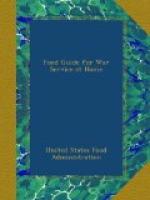THE WAR AND THE EUROPEAN MEAT-SUPPLY
Imports of both animals and fodder are interrupted. With meat as with wheat, the great shortage is due to lack of ships. Australia and New Zealand, and to a lesser extent South America, are cut off. Fodder such as cottonseed press-cake cannot be shipped in large amounts as it takes three times as much shipping to transport feed as it does the meat made by the animals from it. Denmark’s supply of animals to Great Britain has practically stopped, because of her own shortage, and because much of what she has goes to Germany.
The European herds have been cut down. Every one of the warring countries has fewer meat animals now than before the war. There were roughly 100,000,000 animals less in Europe at the end of 1917 than in 1914. Many of those left are in very poor condition, so that the shortage is even more serious than is indicated by the falling off in numbers.
Belgium, Serbia, and Roumania are in the worst condition. Practically all the animals in those countries have been killed or confiscated by the invading German and Austrian armies. This is one cause of their terrible famine conditions.
The United Kingdom, France, and Italy have also lost seriously. France is the greatest loser of the three, with more than one-fifth of her herds gone. The enemy has driven off large numbers of her cattle. She, like the others, is in difficulty not only for meat, but for milk. Her situation is complicated by the fact that she has no great cold-storage plants like ours, and so must get meat-supplies at frequent intervals.
Before the war Germany was much better prepared than the Allies in that she had many more animals in proportion to her population than they. But she was more dependent upon imports of feed, and as her commerce has been cut off, she has had to kill her animals faster. Counting up all her animals in terms of cattle according to the amount of meat they would yield, shows a loss of over one-third. For Austria, there are no available figures, but her decrease has probably been larger than Germany’s.
Meat shortage is not a problem by itself, but is closely connected with the shortage of available grain. When cereals are short, they must be fed to human beings rather than to animals. Feeding grain to animals and then eating the animals is not nearly so economical as eating grain directly. For example, when grain is fed to a cow, only 31/2 per cent of the energy of the grain is turned into meat or fat, and 96 per cent is burned up by the cow in its own daily living. When a man eats the grain directly, he uses at least 85 per cent of its energy. Thus 811/2 per cent more of the grain is actually used for human food. So Europe to-day has to sacrifice her herds, and uses grain for bread instead of turning it into meat.
Alongside this shortage has come an increased demand for meat for the great armies. The soldier’s ration always contains more meat than is eaten by the civilian population.




